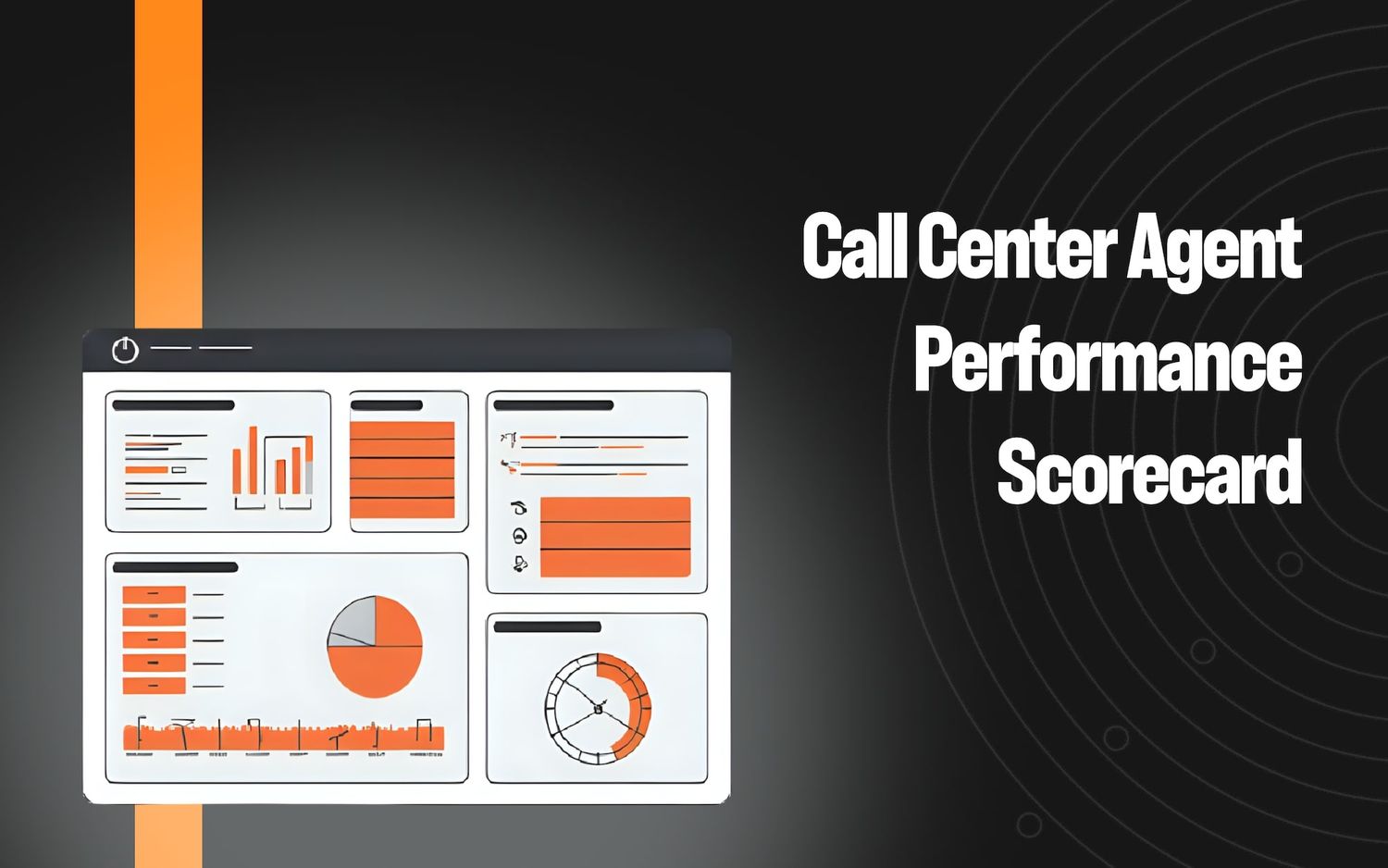AI Call Analytics: A Guide to Choosing the Right Platform

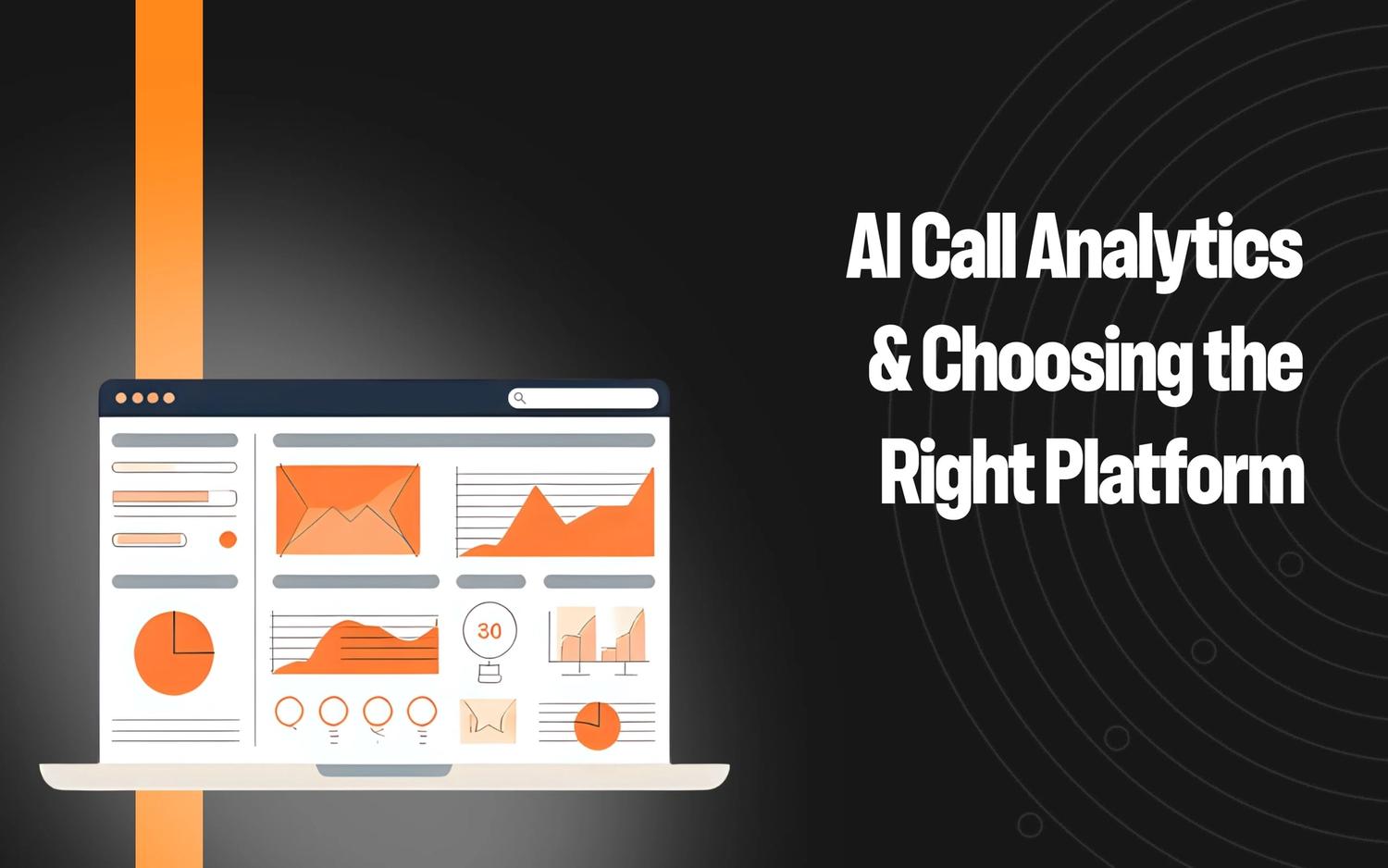
Key Takeaways
- AI-powered call analytics reveals deeper customer insights by analyzing sentiment, intent, and emotional tone.
- Automated QA and agent scoring ensure 100% of calls are reviewed for performance and compliance.
- Custom dashboards unify customer data for targeted reporting and faster decisions.
- Real-time monitoring and alerts help supervisors intervene during live calls to reduce risk and improve outcomes.
- Advanced tools like Level AI detect context and emotion beyond keywords, unlocking better automation and coaching.
AI call analytics transforms unstructured voice and text interactions into actionable insights.
By combining speech recognition with natural language understanding, it captures the full context, intent, and sentiment behind every conversation, not just surface-level metrics like call length or volume. This gives teams a clearer view of how well agents are serving customers and how efficient and personalized the overall experience really is.
More than just monitoring, AI call analytics surfaces recurring issues and performance patterns early, enabling teams to refine workflows and address problems before they grow.
In this article, we break down how AI call analytics works and highlight four essential capabilities to look for in a platform. We’ll be using Level AI as a working example of how these features drive better customer service and stronger agent performance.
The capabilities we’ll cover are:
- Advanced sentiment and intent detection
- Automated agent scoring and QA tools
- Customizable dashboards and reports
- Live call monitoring with alerts and insights
How AI Call Analytics Works
AI call analytics is based on call recording and automatic speech recognition (ASR) technology, which converts spoken words into written text and allows the software to analyze what callers are saying.
Platforms record and transcribe speech for QA purposes using ASR, and also use it to transcribe live calls for real-time speech analytics. The speed and accuracy of ASR, especially for live calls, are vital for QA applications. Once calls are transcribed, NLP, AI, and machine learning techniques are applied to extract valuable insights.
NLP is a basic technology used by all conversational and voice agent systems for intent and sentiment analysis.. It converts raw text into structured data, making it possible to detect topics, classify intent, identify emotions, and summarize conversations.
The rule-based systems of traditional call analytics platforms use NLP to decipher meaning from recognized keywords, and many systems still work in this way; some even claim to use artificial intelligence when they’re in fact using rule-based systems.
Advanced systems using real AI, however, combine natural language understanding and semantic intelligence to grasp the full context and intent of customer conversations, not just keywords. AI tools for customer support offer deeper analysis, more accurate sentiment analysis, and more meaningful automation of tasks in quality assurance, coaching, and customer insight generation.
These provide a better understanding of the “why” behind a customer call than any keyword-based system, which often misses nuance, context, and emotional cues, leading to shallow insights and limited automation potential.
For example, imagine a brand looking to flag the word “return” in conversations. This approach might catch clear statements like “I want to return this dress,” but it might also mislabel irrelevant ones like “I don’t want to return the dress” or “I like my other dress.”
Even when a return is mentioned, keyword systems miss the “why,” a key insight that’s routinely captured by semantic intelligence engines. There’s a big difference between a customer returning an item due to sizing issues versus ordering multiple items and sending back the ones they don’t want. Understanding those reasons has real business value.
Brands using systems equipped with a human-like understanding of context and sentiment can tag and analyze conversations with depth and accuracy, unlocking a wide range of applications such as:
- Analyzing the root cause of product returns
- Detecting churn risks proactively
- Spotting trends across customer complaints
- Automatically recognizing agent compliance violations
- Surfacing training opportunities based on real customer feedback
AI and call center performance management software can also derive voice of the customer (VoC) data from customer conversations without relying on surveys, giving teams a deep understanding of what customers care about and how they perceive their brand.
Despite this automation, however, human oversight remains crucial for scaling safely and effectively, since AI performs best in a supportive role for humans.
We believe the real value of artificial intelligence lies in its ability to help scale QA efforts and call center efficiency, and to allow teams to decide where best to automate.
4 Must-Have Features in an AI Call Analytics Platform
1. Advanced Sentiment & Intent Detection
Analyzing what customers say and how they’re saying it using speech analytics software reveals patterns like frustration, confusion, or dissatisfaction, which helps identify recurring customer pain points such as product issues, slow service workflows, or agent knowledge gaps.
Accurately identifying intent allows systems to efficiently route calls to agents best equipped to resolve particular issues, which helps reduce average handle time (AHT), optimize first call resolution (FCR), and improve contact center QA best practices.
See our latest article on how to improve quality assurance in a call center.
Below are examples of how an AI-powered call analytics solution uncovers customer intent and emotions.
Use Natural Language to Classify Conversations
When evaluating platforms, a top priority should be whether they can accurately capture the real intent of conversations and classify them using natural language understanding.
An example of such a system is Level AI’s Scenario Engine, which recognizes the intent expressed by customers and agents during interactions and labels these as scenarios.
It uses conversational and semantic intelligence to detect subtle cues and phrasing that suggest certain intents, even when the wording varies.
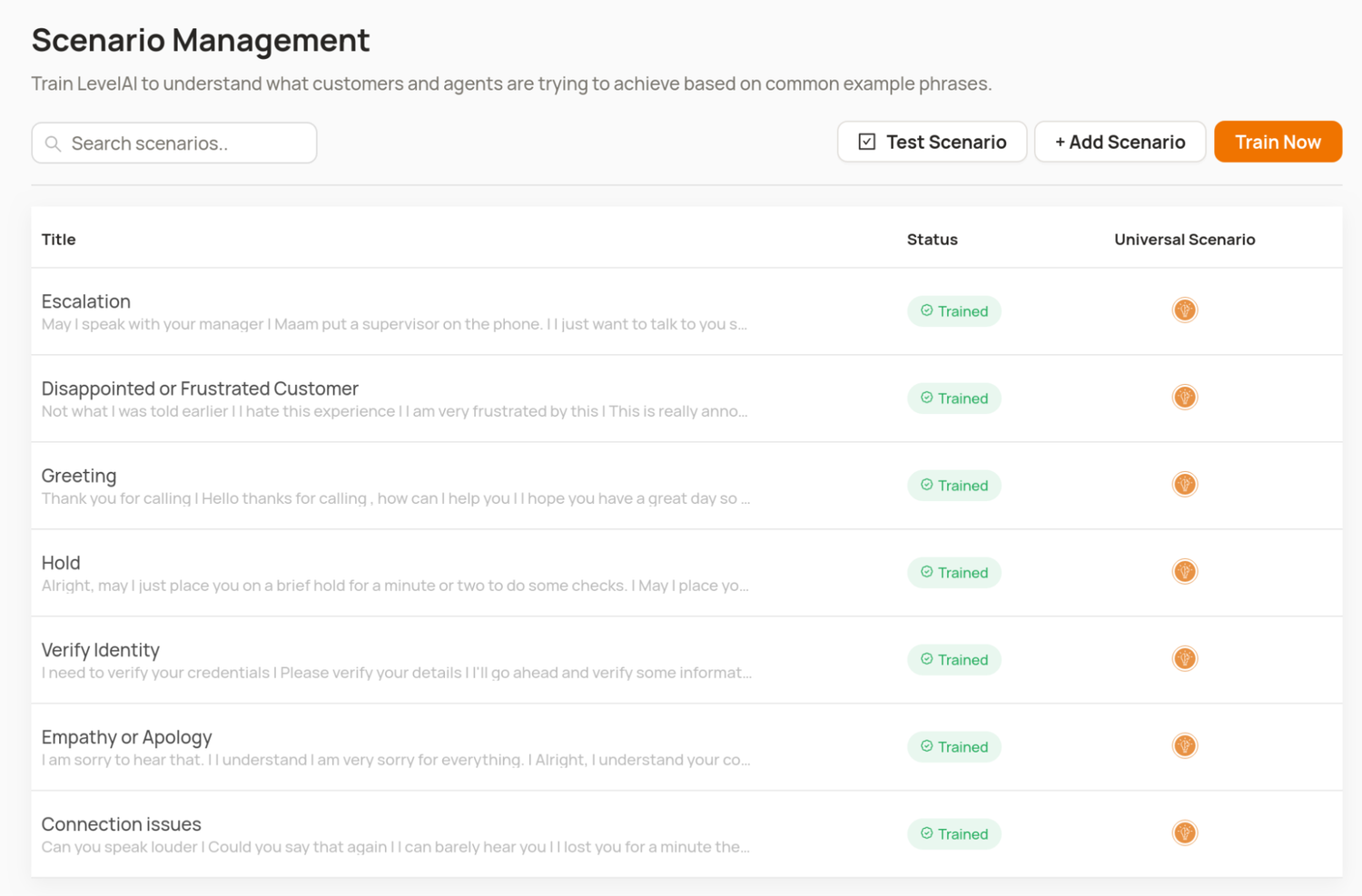
For example, a customer saying “I’m not happy with the cost for this,” “I’ve been price shopping,” or “My subscription is too expensive” would all be classified as Price Sensitivity or Discount-Seeking scenarios, despite no common keywords.
Scenarios are indicated by conversation tags in call transcripts, allowing QA analysts, managers, coaches, and others to see instantly which intents were expressed on any given call.
These tags are searchable and filterable, allowing users to create curated lists of conversations where common intents were expressed.
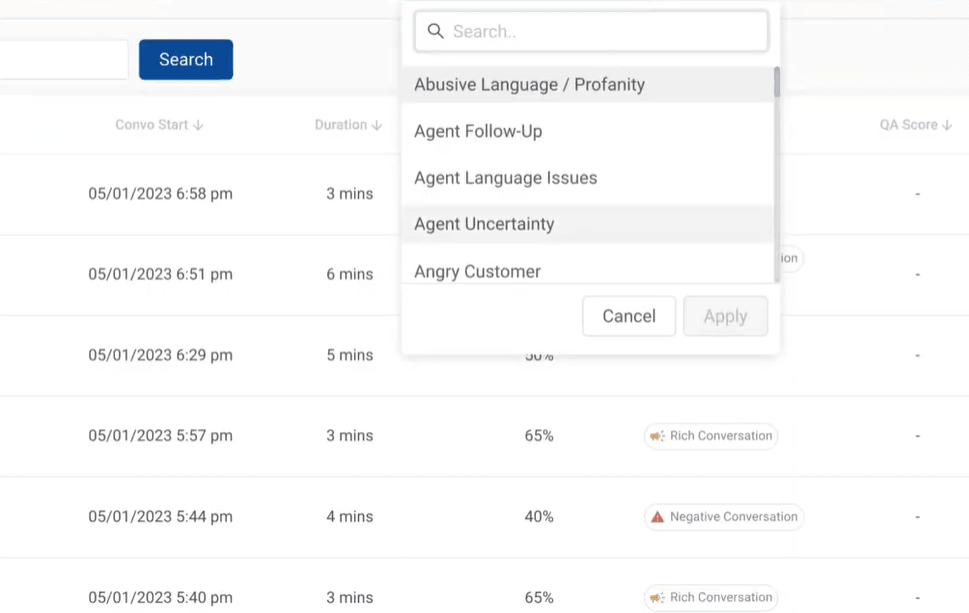
You can also build custom reports around any given tag to correlate intent with a wide range of operational and customer experience metrics.
For example, using Level AI’s Query Builder (described further down), you can build a report showing how often agents handle price or shipping complaints fully in the first interaction by plotting conversation tags for “Price Frustration” or “Shipping Delay” against FCR.
Measure the Emotional Arc of a Conversation
Level AI’s platform assigns a Sentiment Score to each conversation, capturing the overall emotional tone expressed by the customer throughout the interaction.
Sentiment scoring is challenging because customers often express multiple, sometimes conflicting emotions (e.g., gratitude, frustration, confusion, relief) during a single call, but at different stages, for example, during long wait times or whether the agent is being helpful.
For instance, a conversation might start calmly but escalate into anger if the customer feels ignored or mistreated. Or a customer might express happiness or relief at the end of a call after receiving help, even though they felt frustrated during most of the experience.
To reflect this complexity, Level AI classifies actual emotions rather than relying on simplistic labels (like classifying sentiment as simply positive, negative, or neutral), allowing the system to capture the full range and progression of customer feelings throughout the interaction.
Our platform’s sentiment analysis discerns the highest number of emotions of any software in its category. These include:
- Anger
- Annoyance
- Disapproval
- Disappointment/Sadness
- Worry
- Happiness
- Admiration
- Gratitude or Appreciation
Then, the platform aggregates these emotions and creates an overall weighting on a 0–10 scale, where 0 is strongly negative and 10 is strongly positive. The platform uses a non-linear weighting system to reflect their impact on the final score:

Emotions expressed later in the conversation carry more weight, as they more accurately reflect a customer's lasting feelings about your brand as a result of the call’s resolution (or lack of any).
Beyond scoring, the system also tags specific emotional moments or shifts occurring during the conversation (e.g., spikes of frustration, moments of delight) using sentiment tags, making it easy to pinpoint where emotional shifts occurred.
Similar to conversation tags, sentiment tags are searchable and filterable, and allow you to build detailed reports correlating different data with occurrences of sentiment shifts in conversations.
Auto-Summarize Customer Conversations
AI call analytics platforms can generate concise, context-aware summaries that highlight only the most relevant details, making it easy to read the purpose and outcome of any conversation at a glance rather than reviewing full transcripts.
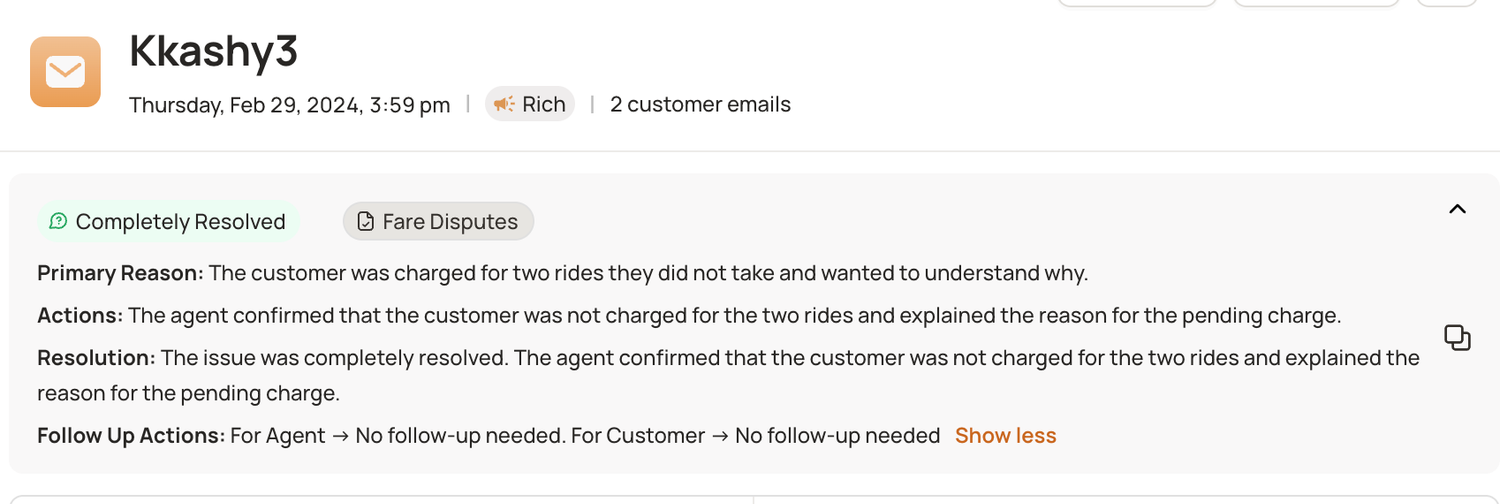
This information lets you quickly see what steps an agent took and whether the agent or customer is expected to follow up.
2. Automated Agent Scoring & QA Tools
Auto-Score Agent Performance Based on Rubrics
Without AI speech analytics, QA teams and managers must select and listen through entire calls to find issues, which typically amount to around 1–2% of the total volume of calls in a contact center.
Doing manual call analysis this way tends to miss certain larger patterns in agent behavior that are only visible when analyzing a much broader set of conversations. This can ultimately leave gaps in coaching and give an incomplete picture of overall performance.
AI’s ability to auto-score every conversation using consistent, customizable rubrics allows teams to surface these broader patterns, making it easier to identify trends, track compliance, and deliver more targeted and effective coaching.
An example of this is Level AI’s InstaScore, which automates call review and agent performance scoring so that QA teams and managers can identify strong and weak performance over 100% of calls.
InstaScore uses predefined rubrics to evaluate agent performance during every call, helping track performance over time. Every customer conversation gets an InstaScore, expressed as a single percentage value, providing an at-a-glance assessment of agent performance.
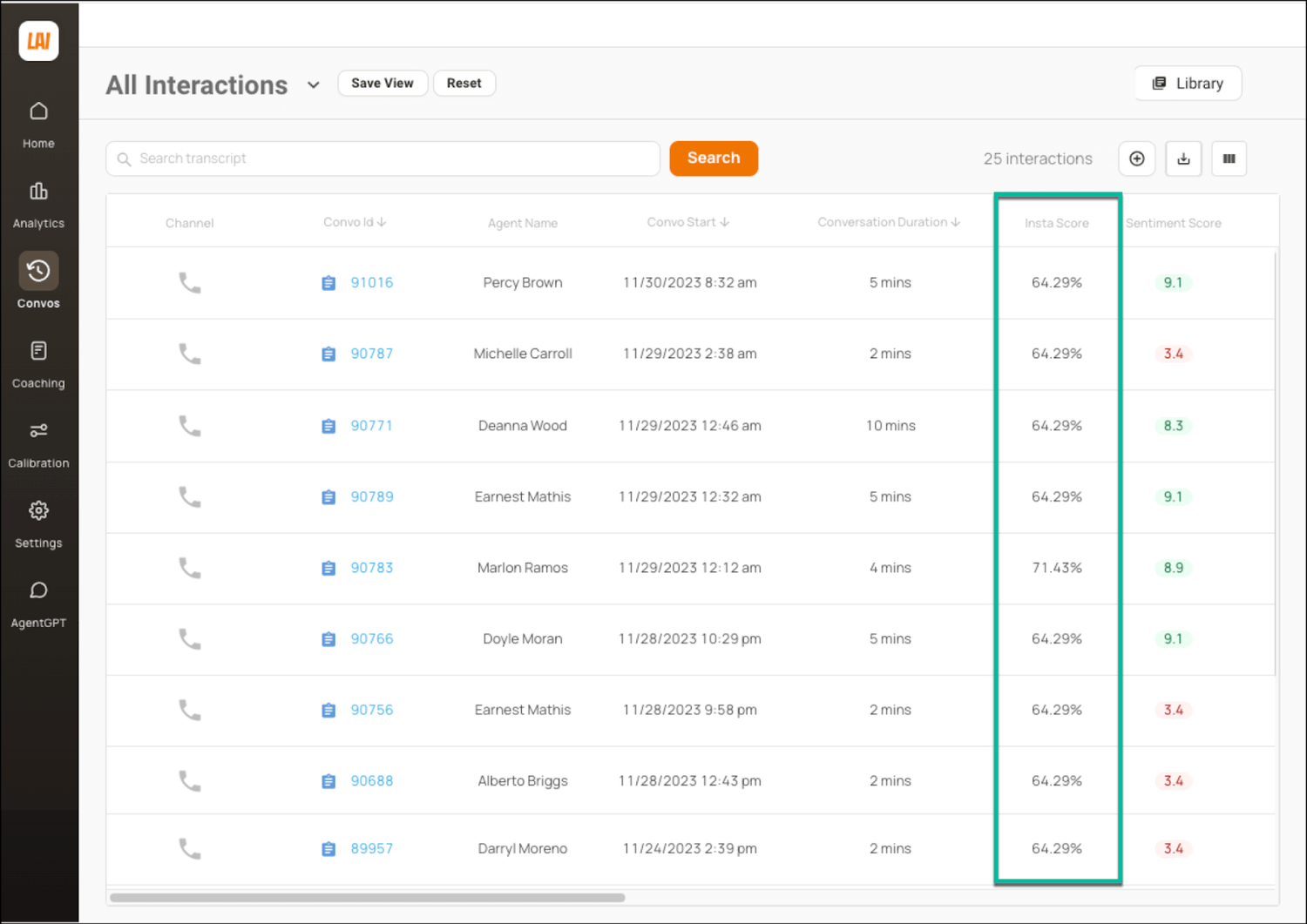
InstaScore rates agent performance based on questions like:
- Was the customer greeted in a professional and friendly manner?
- Was identity verification completed accurately and efficiently?
- Did the agent demonstrate solid knowledge of the product or policy in question?
- Was any inappropriate or prohibited language avoided?
Moving Beyond Surveys to Understand Your Customers
An effective AI-driven call analytics platform should go beyond scoring individual agent-customer interactions; it should also surface broader business performance and customer experience data.
Such voice of customer software often gathers data through post-call surveys, but this approach is imperfect due to low response rates and survey avoidance behaviors, like agents ending calls early to avoid triggering a survey and impacting their CSAT.
A more reliable and scalable approach is to use customer interaction analytics to derive such call data automatically without customers needing to opt in or take extra steps.
Level AI uses such analytics to deliver insights into emerging customer concerns, sentiment trends, and recurring friction points (it also provides standard VoC metrics like CSAT and NPS), presenting them in a unified, easy-to-read dashboard:
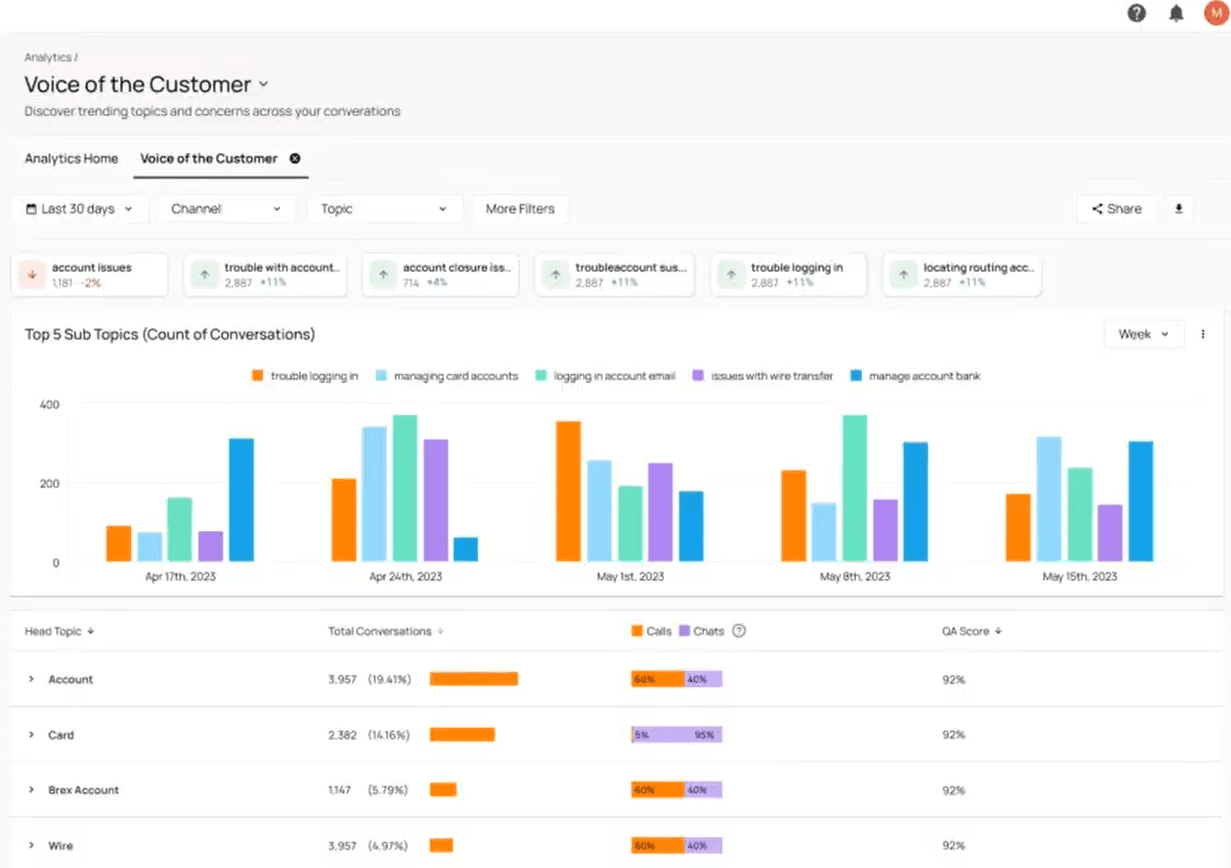
VoC Insights extracts subtle and specific patterns from your call data, such as frequent customer complaints about login issues or account closures. For example, if agents repeatedly offer full device replacements when a basic fix would suffice, the platform can surface this pattern, helping reduce unnecessary costs.
Such findings help identify organization-wide trends and previously unseen friction points that can be addressed strategically.
A buy-now-pay-later company used Level AI’s VoC Insights to spot the content their chatbot was missing. By updating it with the questions customers actually cared about, they avoided a flood of support calls during Black Friday and Cyber Monday. Call volume only rose 6%, not the 150% they expected, saving the company approximately $2 million.
3. Customizable Dashboards & Reports
Many contact centers rely on a patchwork of tools, each capturing only part of the customer journey. Insights from call analysis live in separate dashboards, call data is siloed by channel, and teams are forced to stitch together reports manually just to understand what’s working and what’s not.
This commonly affects reporting, as it can be challenging to tie together disparate silos that provide a clear view of operations and customer experience.
Look for tools offering flexible integrations that unify customer data from across systems so your reporting reflects the full customer journey and supports faster, more informed decision-making.
Level AI offers pre-built integrations with major contact center providers. Its Query Builder also lets you assemble tailored analytics dashboards from our own data, like sentiment tags, InstaScore, and VoC metrics, and combine these with customer data from outside sources, like your CRM, ticketing solution, knowledge base, and others.
This lets you answer questions such as:
- What types of customer needs or goals are most often associated with successful product or service recommendations?
- How does bringing up promotions or rewards programs during a conversation impact the customer's mood and engagement?
- Are customers who express early frustration more likely to require multiple follow-ups or escalations?
- Do support calls that begin with a billing concern but end positively tend to result in stronger customer satisfaction ratings?
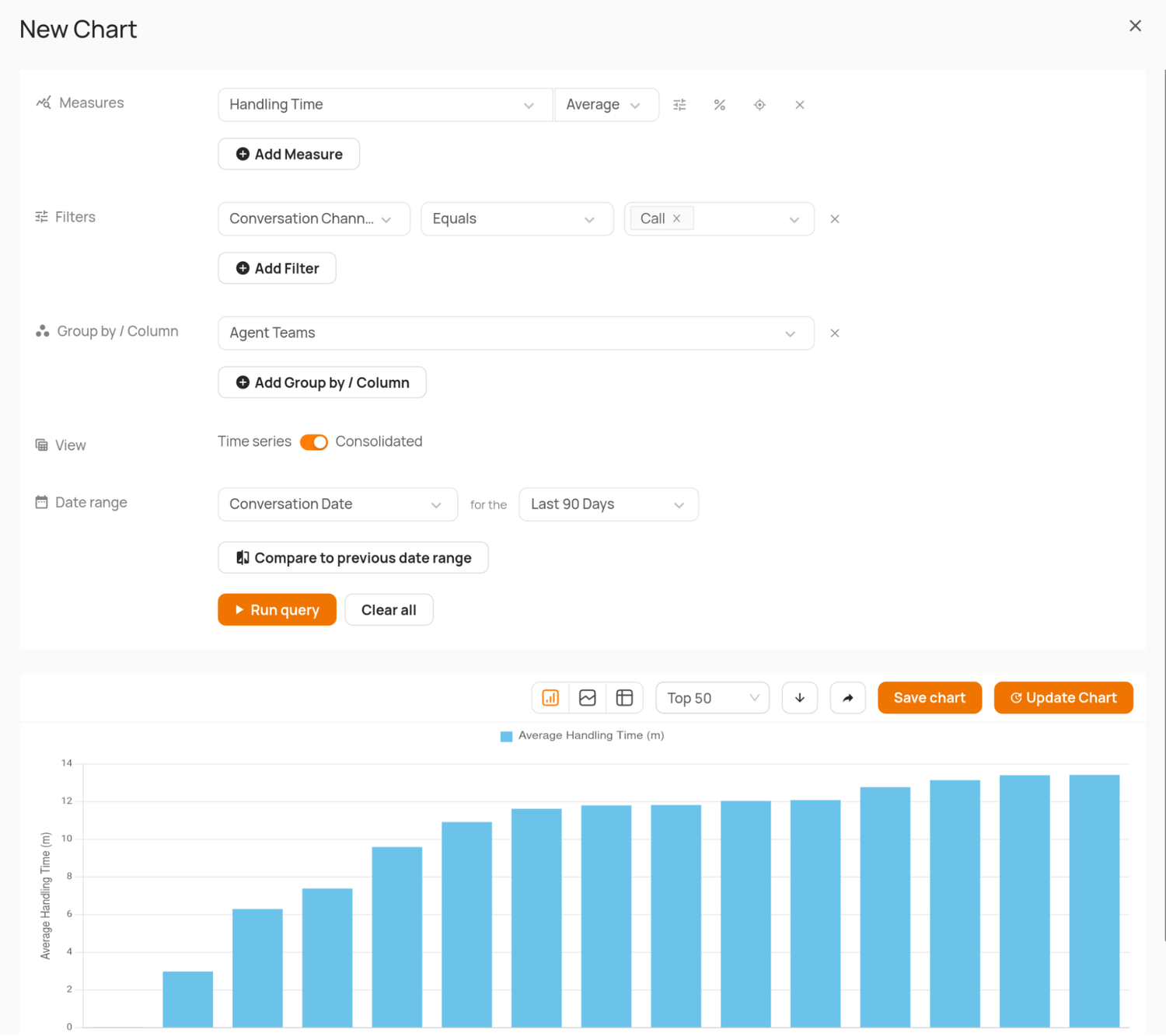
Once reports are generated, Level AI’s roles and permissions provide easy access control, allowing you to specify which team members can view or edit any call center analytics dashboard and share them via email.
4. Live Call Monitoring with Alerts & Insights
The real challenge of real-time oversight isn’t just capturing basic metrics about calls, but delivering timely, actionable insights that supervisors can use immediately.
An example of this is Level AI’s Real-Time Manager Assist, which monitors conversations and provides performance metrics in real time, like:
- Call duration
- Customer Sentiment Score
- Conversion probability
- Deal size
- Agent InstaScore
Its dashboard shows you all live conversations in one place:
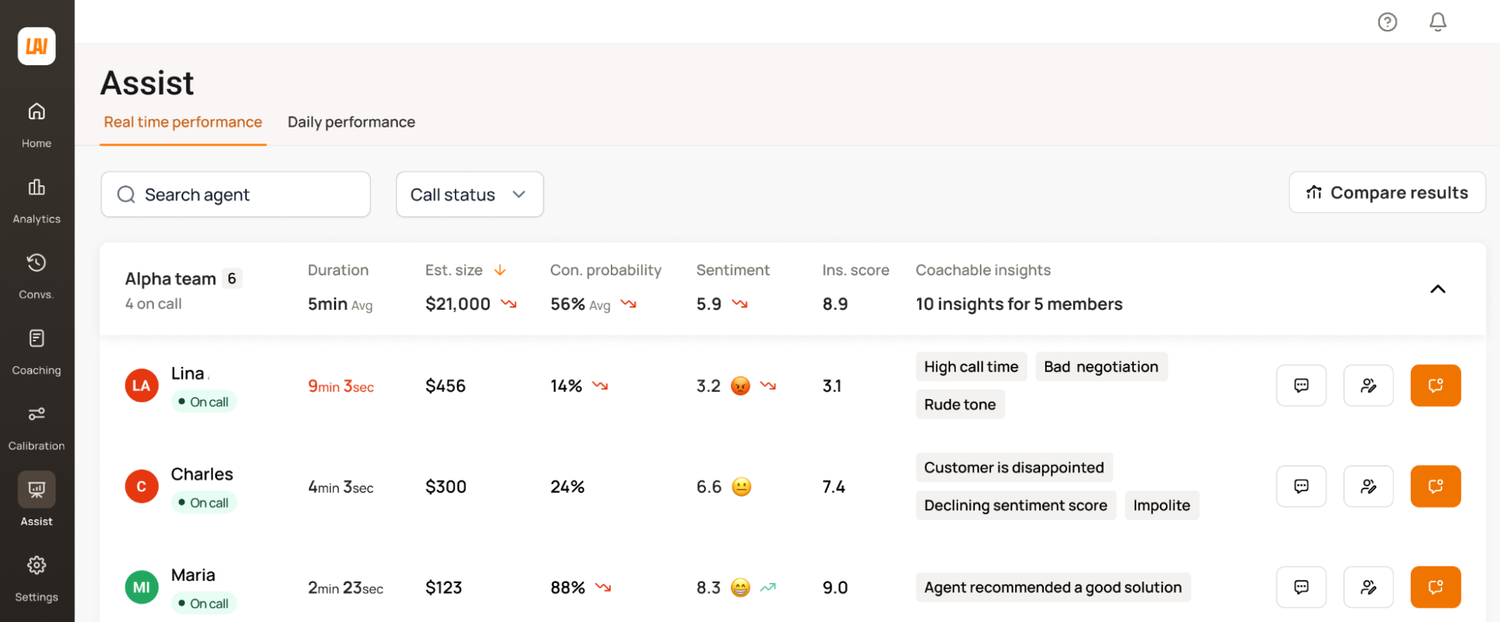
To investigate a call further, you can click on any of the KPIs shown to view supporting evidence like conversation snippets and more detailed metrics.
You can also set up custom alerts that ping you on Slack or Microsoft Teams when certain situations, like a potential churn, arise.
One of our customers, a multinational design and marketing firm, used Real-Time Manager Assist to curb unnecessary refunds and enforce standardized de-escalation protocols across their global support centers.
An internal audit revealed that 30% of issued refunds were unwarranted, often used by agents as a shortcut to resolve tense conversations rather than following approved processes. Leadership recognized this as both a training gap and a cost risk.
After rolling out consistent de-escalation protocols, the QA team used Level AI to monitor live conversations, flag deviations in real time, and identify where agents needed additional coaching.
The impact was significant: unnecessary refunds dropped, saving the company over $30 million in the first year. At the same time, improved agent behavior and support quality led to a 47% boost in customer satisfaction scores.
See our latest article on how to monitor call center performance.
Find Out What True Conversational Intelligence Looks Like
Imagine knowing not just what was said, but what it meant, and what to do about it. That’s the value of conversational intelligence and AI-driven call analysis.
Schedule a demo today to see how scalable quality assurance at every touchpoint leads to better coaching, smoother operations, and more consistent service.
Keep reading
View all

